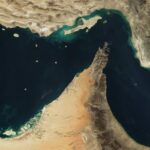Energy News Beat
The Strait of Hormuz, located between Oman and Iran, connects the Persian Gulf with the Gulf of Oman and the Arabian Sea. The Strait of Hormuz is the world’s most important oil chokepoint because large volumes of oil flow through the strait. In 2022, its oil flow averaged 21 million barrels per day (b/d), or the equivalent of about 21% of global petroleum liquids consumption. In the first half of 2023, total oil flows through the Strait of Hormuz remained relatively flat compared with 2022 because increased flows of oil products partially offset declines in crude oil and condensate.
Chokepoints are narrow channels along widely used global sea routes that are critical to global energy security. The inability of oil to transit a major chokepoint, even temporarily, can create substantial supply delays and raise shipping costs, increasing world energy prices. Although most chokepoints can be circumvented by using other routes, which often add significantly to transit time, some chokepoints have no practical alternatives.
Between 2020 and 2022, volumes of crude oil, condensate, and petroleum products transiting the Strait of Hormuz rose by 2.4 million b/d as oil demand recovered after the economic downturn from the COVID-19 pandemic. In the first half of 2023, shipments of crude oil and condensates dropped because OPEC+ members implemented crude oil production cuts starting in November 2022. Flows through the Strait of Hormuz in 2022 and the first half of 2023 made up more than one-quarter of total global seaborne traded oil. In addition, around one-fifth of global liquefied natural gas trade also transited the Strait of Hormuz in 2022.
Note: World maritime oil trade excludes intra-country volumes except those volumes that transit the Strait of Hormuz. LNG=liquefied natural gas. 1H23=first half of 2023.
Only Saudi Arabia and the United Arab Emirates (UAE) have operating pipelines that can circumvent the Strait of Hormuz. Saudi Aramco operates the 5-million-b/d East-West crude oil pipeline and temporarily expanded the pipeline’s capacity to 7 million b/d in 2019 when it converted some natural gas liquids pipelines to accept crude oil. The UAE links its onshore oil fields to the Fujairah export terminal on the Gulf of Oman with a 1.5 million b/d pipeline.
Iran inaugurated the Goreh-Jask pipeline and the Jask export terminal on the Gulf of Oman with a single export cargo in July 2021. The pipeline’s capacity was 0.3 million b/d at that time, although Iran has not used the pipeline since then. We estimate that around 3.5 million b/d of effective unused capacity from these pipelines could be available to bypass the strait in the event of a supply disruption.
Based on tanker tracking data published by Vortexa, Saudi Arabia moves more crude oil and condensate through the Strait of Hormuz than any other country, most of which is exported to other countries. Around 0.5 million b/d transited the strait in 2022 from Saudi ports in the Persian Gulf to Saudi ports in the Red Sea.
We estimate that 82% of the crude oil and condensate that moved through the Strait of Hormuz went to Asian markets in 2022. China, India, Japan, and South Korea were the top destinations for crude oil moving through the Strait of Hormuz to Asia, accounting for 67% of all Hormuz crude oil and condensate flows in 2022 and the first half of 2023.
Note: 1H23=first half of 2023.
In 2022, the United States imported about 0.7 million b/d of crude oil and condensate from Persian Gulf countries through the Strait of Hormuz, accounting for about 11% of U.S. crude oil and condensate imports and 3% of U.S. petroleum liquids consumption. U.S. crude oil imports from countries in the Persian Gulf have fallen by half since 2018 as domestic production has increased.
The post The Strait of Hormuz is the world’s most important oil transit chokepoint appeared first on Energy News Beat.








